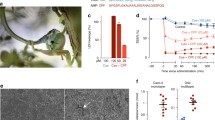Summary
Frogs(Rana pipiens) fed on blister beetles (Meloidae) or cantharidin, retain cantharidin systemically. After cessation of feeding, they void the compound relatively quickly. Systemic cantharidin does not protect frogs against ectoparasitic feeding by leeches(Hirudo medicinalis) or predation by snakes(Nerodia sipedon). As suggested by our data, and from reports in the early literature, ingestion of cantharidin-containing frogs can pose a health threat to humans.
Similar content being viewed by others
References
Brattsten LB (1986) Fate of ingested plant allelochemicals in herbivorous insects. Pp 211–255in Brattsten LB & Ahmad S (eds) Molecular Aspects of Insect-Plant Associations. New York: Plenum Press
Carrel JE, Eisner T (1974) Cantharidin: potent feeding deterrent to insects. Science 183:755–757
Carrel JE, Doom JP, McCormick JP (1985) Quantitative determination of cantharidin in biological materials using capillarygas chromatography with flame ionization detection. J Chromatog Biomed Appl 342:411–415
Committee on Food Protection, National Research Council (1973) Toxicants occurring naturally in foods. Washington, D.C.: National Academy Sciences Press
Harborne JB (1988) Introduction to Ecological Biochemistry. New York: Academic Press
Kaiser E, Michl H (1958) Die Biochemie der tierischen Gifte. Wien: Franz Deuticke
Kelling ST, Halpern BP & Eisner T (1990) Gustatory sensitivity of an anuran to cantharidin. Experientia (in press)
Korschgen LJ, Moyle DL (1955) Food habits of the bullfrog in central Missouri farm ponds. Amer Midland Naturalist 54:332–341
Liener IE (1974) Toxic Constituents of Animal Foodstuffs. New York: Academic Press
McCormick JP, Carrel JE (1987) Cantharidin biosynthesis and function in meloid beetles. Pp 307–350in Prestwich GD & Blomquist HF (eds) Pheromone Biochemistry. Orlando: Harcourt, Brace, Jovanovich
Meynier J (1893) Empoisonnement par la chair de grenovilles infestées par des insectes du genreMylabris de la famille des méloides. Archiv de Medicine et de Pharmacie Militaires 22:53–56
Polson CJ, Tattersall RN (1959) Clinical Toxicology. Philadelphia: Lippincot
Till JS, Majmudar BN (1981) Cantharidin poisoning. Southern Med J 74:444–447
Vézien M (1861) Note sur la cystide cantharidienne par l'ingestion de grenouilles qui sont nourries de coléoptères vésicants. Recueil de Mémoires de Medicine de Chirurgie et de Pharmacie Militaires 4:457–460
Author information
Authors and Affiliations
Additional information
Paper no. 95 of the seriesDefense Mechanisms of Arthropods; no. 94 is LaMunyon & Eisner, Psyche (in press)
Rights and permissions
About this article
Cite this article
Eisner, T., Conner, J., Carrel, J.E. et al. Systemic retention of ingested cantharidin by frogs. Chemoecology 1, 57–62 (1990). https://doi.org/10.1007/BF01325229
Received:
Accepted:
Issue Date:
DOI: https://doi.org/10.1007/BF01325229




